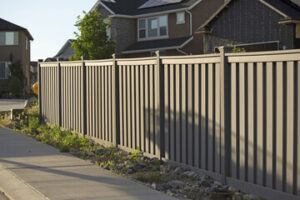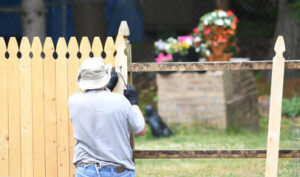Fence Installation Anchorage AK is a project that requires time and effort. Depending on the type of fence and material, the installation process can take anywhere from a few days to a couple months.

Before beginning the project, it is important to review property lines and acquire any necessary permits. It is also a good idea to check with neighbors to see if they would like to share the cost of the fence.
The cost of fence installation can vary considerably, depending on the type of materials and style chosen. Some fences require painting, and this adds to the overall project cost. It is important to consider all aspects of the project when determining a budget. The best way to determine a fair price for a fence is to get estimates from several contractors. Then, double-check the math and make sure you have all the costs of materials included in your estimate. It will save you time in the long run.
The size of the area being fenced will also affect the cost. Using stakes to mark the corners of the yard will help you to determine the perimeter of the fencing area. Then, you can measure the length and width of the area to get an accurate estimate of the materials needed. You should also take into account any obstacles on the property, such as rocks or trees. This will help you to avoid unnecessary trips to the home improvement store.
Another factor that impacts the cost of a fence is its height. The minimum requirement for a residential fence is six feet tall, but a homeowner can choose a higher height if they want to. The price of materials will increase with each foot of additional height. In addition, a gate will add to the cost.
Fences can be made of a variety of materials, from wood to steel and chain link. Each type has its own advantages and disadvantages, so it is important to weigh the pros and cons of each option before choosing a material. A fence is a major investment, and you want to ensure that it will last for a long time.
In addition to the cost of materials, homeowners should also consider any applicable taxes or fees. For example, a fence installation may require a permit from the city or homeowner’s association. These fees will be reflected in the final bill. Then, homeowners can compare the costs of different materials to find the best deal.
Depending on the type of fence, installing a new one may also be tax-deductible. However, homeowners should consult with their accountant or financial adviser before making any decisions about the tax implications of a fence installation.
Materials
There are several materials needed to build a fence, including wood or iron posts and fencing panels. Depending on your preferences, you may also want to consider a privacy screen or other decorative elements for your fence. These are generally more expensive and typically require more care to maintain. However, they can help keep your pets and children safe and secure, as well as improve the appearance of your property.
In addition to these materials, you will need a variety of tools and equipment to complete the project. Some of these include post-drivers, power augers and nail guns, which can make the process much faster and easier. Additionally, you will need a wheelbarrow and work gloves. Lastly, a claw hammer is essential for the construction of a fence and can be used to pound in nails.
While it’s possible to complete a fence with hand tools, these will usually take longer and can be more difficult to use than power tools. For instance, a power auger can speed up digging postholes and ensure that the holes are in the right position to hold a post. Additionally, post-drivers can reduce the strain on arms and wrists when pounding reduced-end posts into the ground.
When building a fence, you will also need a digging bar and a tamping tool. These are useful for breaking up hard dirt and rocky areas, as well as for tamping soil around post corners. In order to prevent rot, it is important that you tamp the soil to ensure that the posts are secured.
Another important piece of equipment for installing a fence is a telescoping ladder, which is used to reach high places that you cannot easily access with a standard ladder. This can be very helpful if you’re trying to install a fence over a pool, or other difficult locations.
Finally, it’s always a good idea to bring a toolbox with a wide range of tools for fence installation. Some of these tools are more useful than others, but it’s always best to have a complete set of tools on hand to make the project go as smoothly as possible.
Installation
A fence is an excellent addition to any property, as it provides privacy and security for children, pets, and livestock. In addition, it can improve the overall curb appeal of your home. However, before you install a fence, it is important to know the process involved. This includes obtaining any necessary permits and licenses. It is also essential to check for any utility lines that may be affected by the construction of a fence. Finally, be sure to research local regulations regarding fence heights and opacity.
The first step in the fence installation process is to obtain a permit from your local building department. This can vary by city, but the requirements are usually similar. Typically, you will need to submit a site plan and a detailed description of the proposed fence. You will also need to review your plans with your neighbors to ensure that the fence does not obstruct access to their property.
Depending on the size of your yard, you can build your own fence or hire a professional to do it for you. A DIY fence can be cheaper, but it can be a difficult project if you have never done it before. Moreover, you may be limited to what is available at your local hardware store. A professional fence company will have more options to choose from and can help you decide what is right for your yard.
After obtaining your permit, the next step is to dig holes for your posts. These should be deep enough to support your desired fence height. Be sure to use a level to ensure that the posts are straight and plumb. You should also consider adding sand to the bottom of each hole for better drainage.
Once the posts are in place, you can move on to the rails. The best time to do this is during the warm, dry months. However, be careful to follow the manufacturer’s instructions when cutting the rails. Some rails require special tools to cut, and others should be set in concrete.
You can then attach the panels to the rails. It is a good idea to use screws instead of nails, which can damage the wood. It is also important to remember to follow safety rules when using power tools.
Maintenance
When a fence is in place, regular maintenance is crucial to preserving its integrity. This includes regular cleaning, repairing damaged sections, and applying protective finishes. Wooden fences benefit from sealant or staining, metal fences need rust-resistant coatings, and vinyl and composite structures need UV-resistant protection to prevent color fading. Applying these finishes at least once every 2-3 years significantly extends the life of fences.
When choosing a contractor for new fence installation or repairs, look for one with extensive experience in the field. This can reduce the overall cost of the project and ensure quality workmanship. A reputable contractor should also carry liability insurance to cover any damage that may occur during the process.
The first step in maintaining a fence is to clean it regularly using mild cleaners and water. Performing this task often can help prevent dirt buildup and minimize the risk of damage from algae or mildew. In addition, cleaning can reduce the risk of damage from pool or lawn chemicals and improve the fence’s appearance.
Next, inspect the fence for loose boards or other signs of wear and tear. If necessary, tighten loose screws or nails and replace any rotting sections. Metal fences require checking for rust, while wooden and composite structures need inspections to identify warping and other issues that can lead to structural problems. Lastly, it’s important to check for vegetation growth that is in contact with the wall. This can cause pressure on the wall over time and should be trimmed regularly to keep a narrow corridor free of plants.
When maintaining a vinyl or PVC fence, it’s important to use mild cleansers and a soft brush to avoid damaging the material. In addition, it’s helpful to periodically lubricate hinges and latches with a silicon-based lubricant to prevent rust and keep the system working smoothly. Additionally, reapplying a UV protectant is vital to preventing color fading in bright sunlight.

